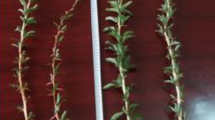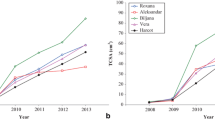Abstract
Bush vigor, berry physical traits and chemical composition, seasonal changes of leaf macronutrients content and leaf mineral status at mid-summer (120 DAFB, Days After Full Bloom) were evaluated in black, red and white currants and their cultivars which are grown on heavy soil, and with reduced cultural practices, except pruning, fertilization with cattle manure and weed control with herbicide, under western Serbian conditions. Results indicated that black currant had lower bush size, yield, bunch weight and number of berries per bunch, but had significantly higher berry weight as compared to red and white currants. Red and white currants had similar bush size, yield and bunch weight. Berries of black currant contained much higher levels of soluble solids content, acidity, vitamin C, total phenolics and flavonoids content than both red and white currants, whereas ripening index was similar. Leaf of black currants had lower macronutrients content, except leaf Mg, as compared with others. Very high excesses of all leaf macronutrients content, except in some cases for leaf N and Mg, were observed in currants in mid summer, i. e. at 120 DAFB. Black currant showed the best balanced nutritional values, whereas red currant showed a wider imbalance in nutritional values. Beside currant species, strong effect of cultivar per se was found on the most of evaluated features. Generally, black currant cv. ‘Eva’, red currant cv. ‘Slovakia’, somewhat ‘Detvan’, and white currant cv. ‘Primus’ had higher bush size, better berry physico-chemical attributes and higher leaf macronutrients content than others. Finally, ‘Eva’, ‘Tatran’ and ‘Meridian’ showed the best balanced nutritional values at 120 DAFB.

Similar content being viewed by others
Abbreviations
- SSC:
-
soluble solids content
- TA:
-
titratable acidity
- RI:
-
ripening index
- TPC:
-
total phenolic content
- TFC:
-
total flavonoid content
- TAC:
-
total antioxidant capacity
- DOP:
-
deviation from optimum percentage
References
Altonen M, Dalman P (1993) The effect of fertilization on leaf and soil analyses of Ribes rubrum L. and Ribes nigrum L. Acta Hortic 352:21–28. doi:10.17660/ActaHortic.1993.352.1
Arya SP, Mahajan M, Jain P (2000) Non-spectrophotometric methods for the determination of vitamin C. Anal Chim Acta 417:1–14. doi:10.1016/S0003-2670(00)00909-0
Bojić M, Janković R, Vukmirović M (1981) The effect of various rate of Dichlobenil on the content of macroelements in red currant leaves. Jug Pomol 55–56:359–364
Bould C (1955) Seasonal changes in the major nutrients of black currant leaves. J Hortic Sci 30:188–196. doi:10.1080/00221589.1955.11513840
Bourne D, Prescott J (2002) A comparison of the nutritional value, sensory qualities, and food safety of organically and conventionally produced foods. Crit Rev Food Sci Nutr 42:1–34. doi:10.1080/10408690290825439
Bratsch A, Williams J (2009) Specialty Crop Profile: Ribes (Currants and Gooseberries). Publication No 438–107. Virginia Cooperative Extension VSU, Petersburg, VA, pp 1–14
Brighente IMC, Dias M, Verdi LG, Pizzolatti MG (2007) Antioxidant activity and total phenolic content of some Brazilian species. Pharm Biol 45:156–161. doi:10.1080/13880200601113131
Cvopa J, Cvopova E, Maliarcikova V (1997) Red and white currants (Ribes L.) bred at the Research Institute of Fruit and Ornamental Woody Plants in Bojnice (Slovakia). Plant Genet Resour 2:113–115
Daglia M (2012) Polyphenols as antimicrobial agents. Curr Opin Biotechnol 23:174–181. doi:10.1016/j.copbio.2011.08.007
Djordjević B, Šavikin K, Zdunić G, Janković T, Vulić T, Oparnica Č, Radivojević D (2010) Biochemical properties of red currant varieties in relation to storage. Plant Foods Hum Nutr 65:326–332. doi:10.1007/s11130-010-0195-z
Donno D, Cavanna M, Beccaro GL, Mellano MG, Torello Marinoni D, Cerutti AK, Bounous G (2013) Currants and strawberries as bioactive compound sources: determination of antioxidant profiles with HPLC-DAD/MS. J Appl Bot Food Qual 86:1–10. doi:10.5073/JABFQ.2013.086.001
FAOSTAT (2016) FAOSTAT Crops. http://faostat.fao.org/beta/en/#data/QC. Accessed 19 Oct 2016
Gutfinger T (1981) Polyphenols in olive oils. J Am Oil Chem Soc 58:966–968. doi:10.1007/BF02659771
Häkkinen SH, Kärenlampi SO, Heinonen IM, Mykkänen HM, Törrönen AR (1999) Content of the flavonols quercetin, myricetin, and kaempferol in 25 edible berries. J Agric Food Chem 47:2274–2279. doi:10.1021/jf9811065
Joghan AK, Ghalavand A, Aghaalikhani M, Gholamhoseini M, Dolatabadian A (2012) How organic and chemical nitrogen fertilisers, zeolite, and combinations influence wheat yield and grain mineral content. J Crop Improv 26:116–129. doi:10.1080/15427528.2011.616985
Jurikova T, Sochor J, Mlcek J, Balla S, Ercisli S, Durisova L, Kynicky J (2014) Polyphenolic compounds and antioxidant activity in berries of four russian cultivars of Lonicera kamtschatica (Sevast.) Pojark. Erwerbsobstbau 56:117–122. doi:10.1007/s10341-014-0215-5
Karjalainen R, Anttonen M, Saviranta N, Stewart D, McDougall GJ, Hilz H, Mattila P, Törrönen R (2009) A review on bioactive compounds in black currants (Ribes nigrum L.) and their potential health-promoting properties. Acta Hortic 839:301–307. doi:10.17660/ActaHortic.2009.839.38
Kazimierczak R, Hallmann E, Rusaczonek A, Rembiałkowska E (2008) Antioxidant content in black currants from organic and conventional cultivation. Electr J Pol Agric Univ 11(2):#28
Khoo GM, Clausen MR, Pedersen HL, Larsen E (2012) Bioactivity and chemical composition of blackcurrant (Ribes nigrum) cultivars with and without pesticide treatment. Food Chem 132:1214–1220. doi:10.1016/j.foodchem.2011.11.087
Kondakov AK, Sirotkina OA (2009) Influence of mineral fertilizers on gooseberry and black currant plant growth. Sadovod Vinograd 3:7–11
Kongsrud KL, Nes A (1999) Effects of fertigation of the black currant cultivar ‘Ben Tron’ (Ribes nigrum L.). Acta Hortic 505:409–414. doi:10.17660/ActaHortic.1999.505.57
Larney FJ, Buckley KE, Hao X, McCaughey WP (2006) Stockpiled and composted beef cattle feedlot manure. J Environ Qual 35:1844–1854. doi:10.2134/jeq2005.0440
Larsson L, Svensson B (1989) Bärodling. LTS Förlag, Stockholm
Larsson L (1997) Evaluation of mulching in organically grown black currant (Ribes nigrum) in terms of its effects on the crop and the environment. Sveriges Lantbruksuniversitetet (SLU), serie Agraria, No 28. http://www.vaxteko.nu/html/sll/slu/agraria. Accessed 11 July 2016
Lee SK, Kader AA (2000) Preharvest and postharvest factors influencing vitamin C content of horticultural crops. Postharvest Biol Technol 20:207–220. doi:10.1016/S0925-5214(00)00133-2
Lenz F, Bünemann G (1975) Einfluß von Bodenpflegemaßnahmen und unterschiedlicher N, K‑Versorgung auf Wachstum und den Ertrag von Schwarzen Johannisbeeren. Erwerbsobstbau 17:161–164
Lindhard-Pedersen H, Hansen P (1996) Effect of timing of nitrogen supply on growth and yield components of young black currants (Ribes nigrum L.) In: Lindhard-Pedersen H, Integrated production of black currants (Ribes nigrum) and sour cherries (Prunus cerasus). Dissertation, The Royal Veterinary and Agricultural University, Copenhagen, Denmark
Ljones B (1963) Leaf composition in apple, raspberry and black currant as related to nutrient elements in the soil. Meld Nor Landbrukshoeg 42:1–89
Määtä K, Kamal-Eldin A, Törrönen R (2001) Phenolic compounds in berries of black, red, green, and white currants (Ribes sp.). Antioxid Redox Signal 3:981–993. doi:10.1089/152308601317203521
Määtä-Riihinen KR, Kamal-Eldin A, Mattila PH, Gonzáles-Paramás AM, Törrönen AR (2004) Distribution and contents of phenolic compounds in eighteen Scandinavian berry species. J Agric Food Chem 52:4477–4486. doi:10.1021/jf049595y
Macheix JJ, Fleuriet A, Billot J (1990) Fruit phenolics. CRC Press, Boca Raton FL
Mikkonen TP, Määtä K, Hukkanen AT, Kokko HI, Törroönen AR, Kärenlampi SO, Karjalainen RO (2001) Flavonol content varies among black currant cultivars. J Agric Food Chem 49:3274–3277. doi:10.1021/jf0010228
Mikulic-Petkovsek M, Schmitzer V, Slatnar A, Stampar F, Veberic R (2012) Composition of sugars, organic acids, and total phenolics in 25 wild or cultivated berry species. J Food Sci 77:1064–1070. doi:10.1111/j.1750-3841.2012.02896.x
Mikulic-Petkovsek M, Slatnar A, Schmitzer V, Stampar F, Veberic R, Koron D (2013) Chemical profile of black currant fruit modified by different degree of infection with black currant leaf spot. Sci Hortic 150:399–409. doi:10.1016/j.scienta.2012.11.038
Milivojevic J, Slatnar A, Mikulic-Petkovsek M, Stampar F, Nikolic M, Veberic R (2012) The influence of early yield on the accumulation of major taste and health related compounds in black and red currant cultivars (Ribes spp.). J Agric Food Chem 60:2682–2691. doi:10.1021/jf204627m
Milošević T (1996) Fruit set of newly-bred currant cultivars and hybrids. Jug Pomol 30:165–169
Milošević T (1997) Special topics in fruit growing. Faculty of Agronomy and Community for Fruits and Vegetables, Cacak, Belgrade
Montañés L, Heras L, Abadía J, Sanz M (1993) Plant analysis interpretation based on a new index: deviation from optimum percentage (DOP). J Plant Nutr 16:1289–1308. doi:10.1080/01904169309364613
Moyer RA, Hummer KE, Finn CE, Frei B, Wrolstad RE (2002) Anthocyanins, phenolics, and antioxidant capacity in diverse small fruits: Vaccinium, Rubus, and Ribes. J Agric Food Chem 50:519–525. doi:10.1021/jf011062r
Niskanen R (2001) Leaf macronutrient composition in relation to growth and yield potential of currants. University of Helsinki, Department of Applied Biology Publication, No 2, Helsinki
Niskanen R (2002) Nutritional status in commercial currant fields. Agric Food Sci 11:301–310
Pantelidis GE, Vasilakakis M, Manganaris GA, Diamantidis G (2007) Antioxidant capacity, phenol, anthocyanin and ascorbic acid contents in raspberries, blackberries, red currants, gooseberries and cornelian cherries. Food Chem 102:777–783. doi:10.1016/j.foodchem.2006.06.021
Pecho L, Takác J, Cvopa J (1993) Nutrient matter contents in fresh and processed currant fruits. Acta Hortic 352:205–208. doi:10.17660/ActaHortic.1993.352.28
Persson J, Kirchmann H (1994) Carbon and nitrogen in arable soils as affected by supply of N fertilizers and organic manures. Agric Ecosys Environ 51:249–255. doi:10.1016/0167-8809(94)90048-5
Prieto P, Pineda M, Aguilar M (1999) Spectrophotometric quantification of antioxidant capacity through the formation of a phosphomolybdenum complex: Specific application of vitamin E. Anal Biochem 269:337–341. doi:10.1006/abio.1999.4019
Rubinskiene M, Viskelis P, Jasutiene I, Duchovskis P, Bobinas C (2006) Changes in biologically active constituents during ripening in black currants. J Fruit Ornam Plant Res 14:236–246
Skrede G, Martinsen BK, Wold AB, Birkeland SE, Aaby K (2011) Variation in quality parameters between and within 14 Nordic tree fruit and berry species. J Acta Agric Scand Sec B Soil Plant Sci 62:193–208. doi:10.1080/09064710.2011.598543
Stanisavljevic M, Mitrovic O, Gavrilovic-Damjanovic J (2002) Biological-pomological properties of some red and white currant cultivars and selections. Acta Hortic 585:237–240. doi:10.17660/ActaHortic.2002.585.38
Wang Q, Tury E, Rekika D, Charles MT, Tsao R, Hao Y‑J, Dubé C, Khanizadeh S (2010) Agronomic characteristics and chemical composition of newly developed day-neutral strawberry lines by Agriculture and Agri-Food Canada. Int J Food Prop 13:1234–1243. doi:10.1080/10942910903013415
Webb RA (1976) The influence of yield components on cultivar differences in black currants. Sci Hortic 5:119–126. doi:10.1016/0304-4238(76)90074-1
Wold AB, Opstad N (2007) Fruit quality in strawberry (Fragaria × ananassa Duch. cv. Korona) at three times during the season and with two fertilizer strategies. J Appl Bot Food Qual 81:36–40
Wu X, Gu L, Prior RL, McKay S (2004) Characterization of anthocyanins and proanthocyanidins in some cultivars of Ribes, Aronia and Sambucus and their antioxidant capacity. J Agric Food Chem 52:7846–7856. doi:10.1021/jf0486850
Yadong L, Rui H, En Z (1993) The establishment of leaf analysis standard of black currant (Ribes nigrum L.) in northeast China. Acta Hortic 352:259–266. doi:10.17660/ActaHortic.1993.352.37
Author information
Authors and Affiliations
Corresponding author
Ethics declarations
Conflict of interest
T. Milošević and N. Milošević declare that they have no competing interests.
Rights and permissions
About this article
Cite this article
Milošević, T., Milošević, N. Vegetative Growth, Productivity, Berry Quality Attributes and Leaf Macronutrients Content of Currants as Affected by Species and Cultivars. Erwerbs-Obstbau 60, 53–65 (2018). https://doi.org/10.1007/s10341-017-0339-5
Received:
Accepted:
Published:
Issue Date:
DOI: https://doi.org/10.1007/s10341-017-0339-5




